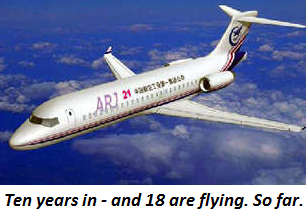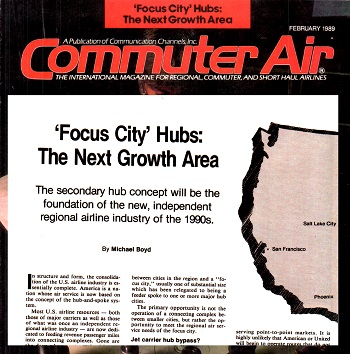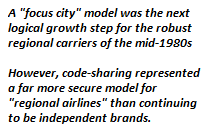Marketing Genius of The Week…
This’ll Get Airlines To Start Buying…
The manufacturer, touting the delivery of the second 76-seat ARJ-21 into China’s new Genghis Khan Airlines, is cutting new territory in personal comfort.
 “Each seat is equipped with a USB charging interface, making it comfortable to ride.”
“Each seat is equipped with a USB charging interface, making it comfortable to ride.”
Ouch. Wonder if Genghis Khan had this feature on the saddles of his Mongolian war ponies? No wonder his troops had such bad attitudes when pillaging the countryside from China to Europe.
But who knows, tush-charging may be the next big thing in inflight entertainment.
By the way, the ARJ-21 first rolled out in 2008. They’ve built 18.
Not exactly a big seller. In what will be the world’s #1 domestic airline market within the next 15 months, that sends messages.
Without any need for a USB port.
__________
Delta’s “Focus City” Concept.
An Approach Finally In Place – After 30 Years
Bear with us for some background verification, and maybe a tinge of promotion.
One of the factors that sets Boyd Group International apart from other consulting firms is that we are actively and independently engaged in research and forecasting of emerging trends in aviation. We are expert in airline, fleet and market strategy shifts. Our enplanement forecasts – Airports:USA – rely on analyses of the air service trends evolving at each of 146 airports.
 No trend-lining and no reliance whatsoever on federal data, the forecasting reliability of which is somewhere south of a defective Quija board.
No trend-lining and no reliance whatsoever on federal data, the forecasting reliability of which is somewhere south of a defective Quija board.
Most other consultants just pull down numbers from laughable government sources, such as completely brain-dead FAA Terminal Area Forecasts.
One example of our independent approach was a study in 1989 that outlined how new market mission capabilities differentiated planned 50-seat jets from similar-capacity turboprops. Back then, that was not understood. Lots of folks simply concluded that 50 seats was 50 seats, regardless of powerplant – an outlook that ignored mission-capability.
Fast forward a dozen years later, after Bombardier and Embraer order-books were practically dog-eared from the all the 50-seat business, BGI was alone in forecasting that the demand for these machines had been fully met, and new orders would be scarce.
At the time, forecasts from other companies showed these machines to have orders well into the next couple decades. These weren’t forecasts. They were blind trendlines.
Then, we could touch on our 2009 and 2014 forecasts of the US-Cuba air service potential – which, to guffaws of the travel industry, were alone in accurately describing the realities of the market, and pretty much that’s what’s transpired.
Same Concept. Different Airline System. Now we have another example.
There’s been a lot of accurate discussion regarding the aggressive “focus city” strategy in place now at Delta Air Lines. It makes sense in both providing access between “secondary” commercial centers, delivering a better product to the consumer, and in freeing up facilities at Atlanta.
 One thing we’d like to point out… We outlined this concept – and we were the first to use the term “focus city” – just a bit over 30 years ago.
One thing we’d like to point out… We outlined this concept – and we were the first to use the term “focus city” – just a bit over 30 years ago.
Then and now, a bit different in implementation, but not in application.
Back then there still existed remnants of a robust independently branded and independently operating regional airline system – with fleets of 19-seat to-30 seat aircraft that had the potential of providing quick nonstops between secondary commercial centers, avoiding major carrier hubsite airports.
Back then, consumers were not averse to riding these machines on intra-regional routes, such as Abilene – Austin, Shreveport-New Orleans, Albany – Islip, and the like. So “focusing” on potential nonstops between mid-size commercial cities made sense – on paper. The idea of delivering nonstop routes – O&D – for places like OKC and OMA and BHM – using small and low sector-cost airplanes had potential.
Like, what Delta is doing today was conceptually viable back them, only the economics and the fleets and the market sizes have changed in scope. It was logical to expect that these then-strong independent regional carriers could well expand such a system into secondary airports across the nation. A shadow system for such airports, concentrating on a specific and defined consumer segment. Back then, they had lots of new airliners on order, and the prognosis was strong expansion.
It was a system that had great growth potential.
Well, at least until the independent regional airline industry was incorporated into major carriers’s systems, due to the advent, DOT approval, and ultimately transformation of the concept of code-sharing.
In a few short years, the application of code-sharing steamrollered from simply putting a major airline booking code on a regional’s flights, to completely shifting the regional’s aircraft into the major’s route planning. In a couple of years time, these small airlines simply were suppliers of lift, and had no specific route system or market brand of their own.
That process, by the mid 1990s, totally eliminated the brand identity and market planning – of regional carriers. Actually, it ultimately eliminated regional airlines as an independent air transportation system.
 The transformation was strictly business – one that made more economic opportunity for the former regional and its shareholders than trying to operate as an independent brand.
The transformation was strictly business – one that made more economic opportunity for the former regional and its shareholders than trying to operate as an independent brand.
Today, those “regionals” that are still in business have morphed into highly professional companies leasing crews and aircraft to major carriers. Heck, the largest such entities are operating E-175s and other planes owned by the major carrier.
As it evolved, code-sharing completely erased the entire independent regional airline industry, and along with it a lot of the air service that it once provided. Poof! went any potential for an independent regional to go, well, independent. So, building a hub-bypass “focus city” program operated by independent regional airlines was out.
But Delta is doing it today – with apparently strong results. The city pairs are larger, due to larger jet aircraft. The focus city model is additive to the hub-connect system, not a replacement.
Different Economics. Different Communication Systems. Evolved Consumer Needs. The interesting observation is that today, the few random independent commuters that are left (mostly focused on EAS, and not proprietary route systems) no longer have any real consumer brand-awareness. That’s another change from 30 years ago… consumers generally don’t support independent carriers with small aircraft. Also, a lot of the need for travel between the cities envisioned in 1989 has been eliminated by other forms of communication.
The recent failure of Via Air underscores this. (Contrary to reports, they had a “passenger shortage” more than a lack of pilots.)
Today, the Delta strategy is very similar in template to what was outlined by BGI three decades ago… it’s just on a much larger scale, and cities like Shreveport are not in the play.
Interested In More Heresy? Join Your Colleagues At The IAFS. Aviation is anything but a stable playing ground… dynamics like the above shift constantly. This is why you need to be in Las Vegas August 25-27 for the International Aviation Forecast Summit.
 Over 20 airline CEOs and senior executives will be there, each outlining what he or she sees at the critical challenges for the industry. In addition, there will be dozens of airline staff in attendance, which will mean plenty of time for networking, too.
Over 20 airline CEOs and senior executives will be there, each outlining what he or she sees at the critical challenges for the industry. In addition, there will be dozens of airline staff in attendance, which will mean plenty of time for networking, too.
The agenda is now posted. If you haven’t registered yet, click here for more information
The IAFS is the only true forecast event in the industry. It’s also the more incisive in regard to exploring new and emerging trends.
This year, we’ll be covering the trends that the rest of the industry will be noticing five years from now… but our attendees will be way ahead of that.
_______________